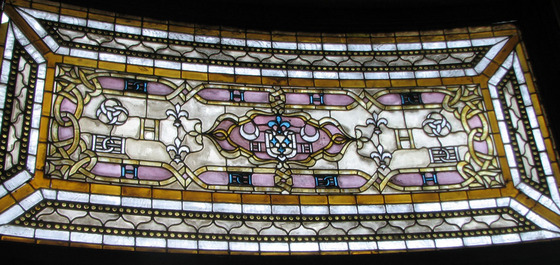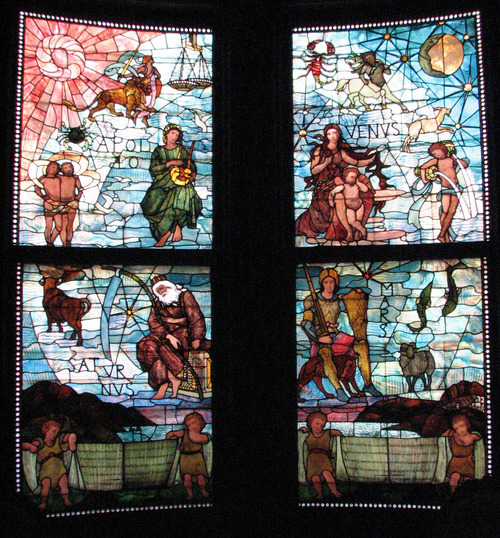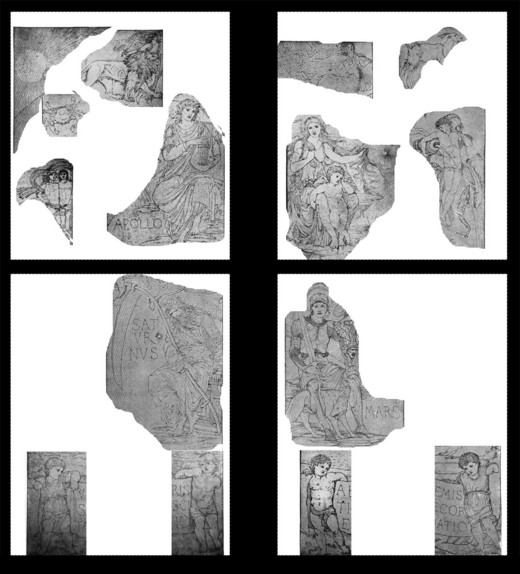May 29, 2009
Stained Glass Day at the Met
On Sunday, May 31, 2009, there will be a day of talks on stained glass at the Metropolitan Museum of Art in New York City, all part of celebrating the opening of the newly refurbished American Wing.
Officially it's called Sunday at the Met—An Old-World Art Form for the New World: Issues in the History of Conservation, Collecting, and American Designs for Stained-Glass Windows.
Whew.
May 27, 2009
AGG 2009 Conference Early Registration Deadline
If you plan to attend the American Glass Guild Conference this coming July, you can save some money by registering by May 31, the deadline for early registration. You can find the Registration Form, Schedule and list of workshops, presentations and speakers and hotel reservation link at 2009 Conference webpage. The Conference will be held in Buffalo, NY, from July 16-20.
Workshops are being held Thursday and Friday Morning. Note that the Thursday full day conservation workshop is full.
You can look at detailed information of sites related to the conference at the Google Map, AGG 2009 Buffalo Conference Sites. The map includes the sites for the Friday morning walking tour and the Monday full day bus tour, as well as locations of local sites of interest. Lots of links.
It's going to be a full weekend. I'll be there, speaking on Friday afternoon (Stained Glass in the Internet Age) and again on Saturday morning (A Quick Primer: Photo Sandblasting and Silk-screening, with Dan Maher). I'll have more details as the time comes closer.
May 24, 2009
Cupples House Stained Glass
I finally got a chance to visit the Samuel Cupples house, on the campus of St. Louis University, St. Louis, MO. "Finally", because their hours tend to be a bit unusual, so it's been difficult before now. As it was, I visited on a Sunday and they were only open because of a special event called "Rooms in Bloom". Whatever the reason it was, all in all, a very pleasant visit.
Richardsonian Romanesque design, Thomas Annan Architect, circa 1889
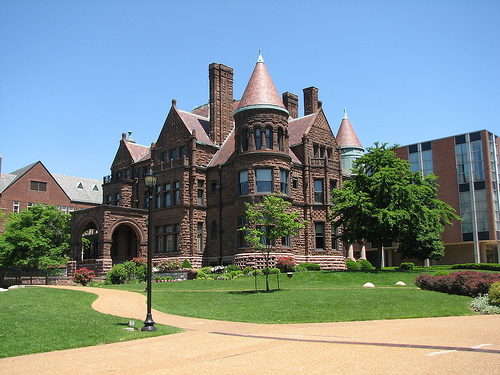
I posted 75 photos from the visit as a VitreosityPictures Flickrset of Samuel Cupples Stained Glass.
Decorative Drawing Room Window, circa 1889.
These were my favorites - very detailed decorative windows, with tiny pieces of glass and string lead throughout. This one looked to be around 18 inches high, with many of the individual glass pieces are no bigger than a fingernail. Great work. There are some 8-10 varied, detailed, decorative windows throughout the house.
Zodiac Window, 1889
This is the window I had heard of, and which used to be featured prominently on their website (but no longer - wassup?).
A placard at the museum stated that this is a Tiffany Studios window based on a design by Edward Burne-Jones. My initial response to the Tiffany attribution is skepticism, as the circumstances and the quality of the panel seem a bit wonky.
How exactly did a Burne-Jones design for a 'Four Seasons' design became a stained glass window for the 'Zodiac'? and by Tiffany Studios? and in St. Louis? I'd always assumed, before I saw it in person, that the Zodiac window was done by a good early St. Louis stained glass studio. The design, fabrication and painting seem a bit crude compared to the Tiffany and LaFarge windows I've seen over the years. I've only ever heard of one Tiffany Studio window being designed "based on" a non-Tiffany studio artist - a panel from 1894 based on a print by Toulouse Lautrec, and the style and circumstances of the commission simply don't match, IMO.
On the other hand, in terms of attribution, the decorative windows throughout the rest of the Cupples House are first rate technically, so it certainly does not rule out the Tiffany Studio.
more on the Zodiac window plus a surprise or 2 below the post...
Zodiac Window deconstructed
The design for the Zodiac window is based on a 'Four Seasons' design by Edward Burne-Jones, though it is not a straightforward translation, one to one. It turns out to be a pretty convoluted move from design to window.
These are images of the original 'Four Seasons' design from the book, Sir Edward Burne-Jones, A Record and Review, by Malcolm Bell. It's not even stated in the book what the design is for - a mosaic? a tapestry? a stained glass window?
from left to right - Spring, Summer, Autumn, Winter
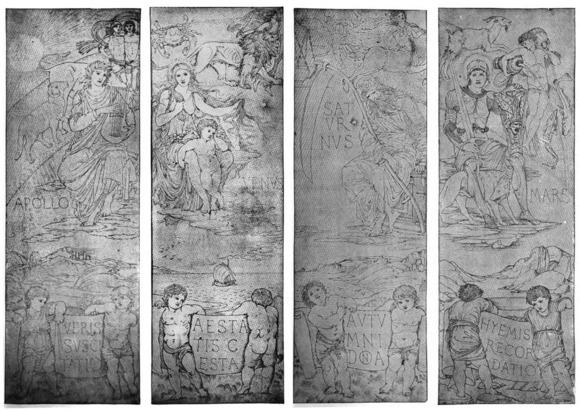
It's a bit of a convoluted translation. This is how the Burne-Jones figures and symbols are reconfigured into the Zodiac. On top of this, a number of symbols were added that were not in the original Burne-Jones design (Ram, fish, Moon with female figure). Additionally, the 4 "Four Seasons" scrolls with Latin text at the bottom are replaced by 2 scrolls with a poem by St. Louis based poet Eugene Field.
This shows what pieces went where and gives an idea of the patchwork nature of the translation -
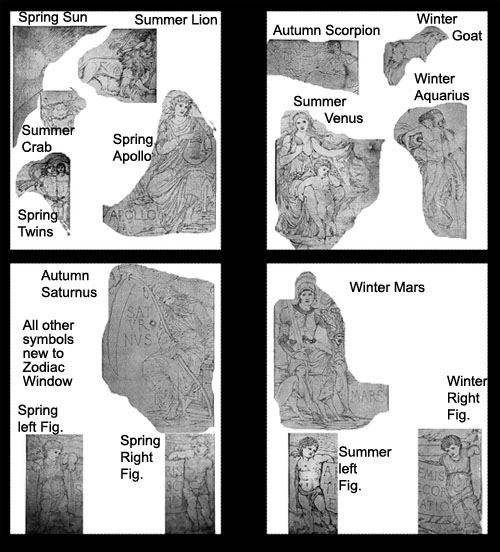
This process is not something I've seen in any other Tiffany Studios window.
Still, more evidence needed.
Whatever the attribution, there is much to like about this window. I especially like this bit of painting, where the white of the glass represents the beard and the paint represents the flesh. No matter the technique, it's a beautifully rendered expression of wearied age.
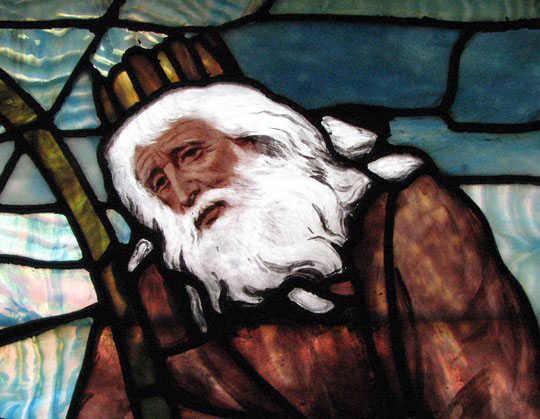
Mosaic Panels
These are a curious set of panels hanging in some windows on the third floor. There were no placards to elaborate. It's possible that they are a part of the glassware collection on the third floor and not original to the house. It's clear from the framing that they were once installed windows, but with no information as to where they were previously installed, or in what context.
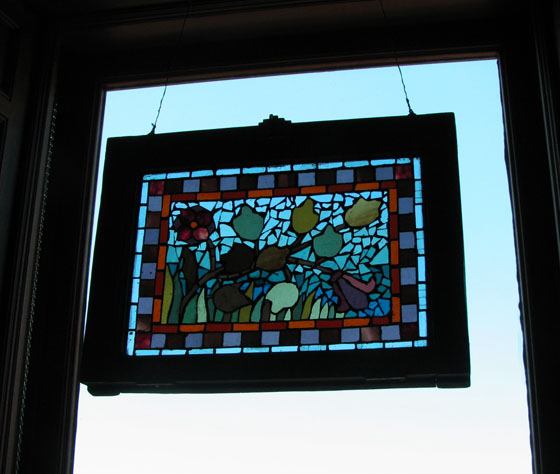
The fabrication technique is also unusual, in that it's done in a pure mosaic style, with pieces laid out and spaces filled in with molten metal or grout, with no lead came or copper foil used to create a channel for the glass to rest in.
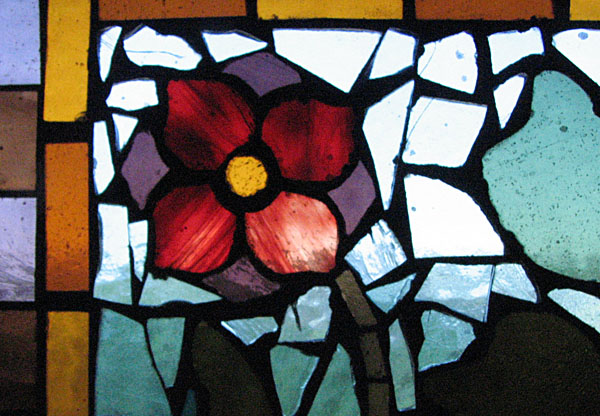
There is no backing plate and a number of the panels are buckling at least a half inch out of plane, so the matrix is likely metal and not any kind of ceramic-style grout. They seem to be done with a similar technique as the Belcher Mosaic process (1884 patent). Closer examination would be needed.
Again, check out the VitreosityPictures Flickrset of Samuel Cupples Stained Glass for more images.
May 20, 2009
Connick Tour in Pittsburgh
An article called Shining a light on stained glass artists, about Charles Connick's stained glass in the Pittsburgh area. This coming Sunday there will be the first in a series of lectures and tours related to Connick stained glass.
Not from Pittsburgh, but a nice early Connick piece I found on Flickr.
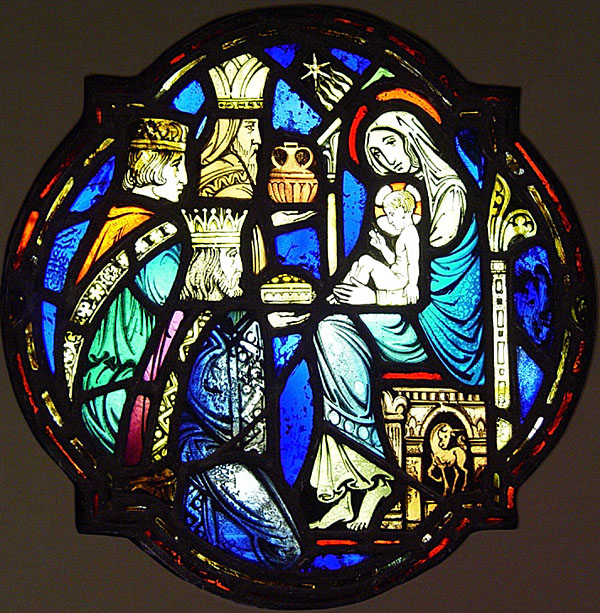
Adoration of the Magi, LACMA, from flickrite howcheng
May 15, 2009
The Tip Jar
You might notice that I've added a button on the left for donations.
I've never asked for money on this site. When I first started this blog in 2003, it didn't occur to me that the idea would ever come up. But after the number and size of entries grew, and there seemed to be a steady readership, then it seemed to me appropriate to either put up a donate button or seek advertising. Frankly, I've never wanted to clutter up the space with advertising, nor do I want to have to consider the agendas of advertisers when writing entries. Advertising on the blog may happen in the future, but with discretion and guidelines.
So a simple, easy to use donate button it is.
Why now? Aside from the stresses of the economy that everyone is feeling, I would like to upgrade the blog. Improve the look and function and, most importantly, bring back comments.
After 5½ years of blogging and over 300 blog posts, I think I can give myself permission to ask. Any help is much appreciated.
May 12, 2009
Met's American Wing Galleries to reopen May 19
The Metropolitan Museum of Art, New York City, is announcing the reopening of the Metropolitan Museum of Art's American Wing.
One of the windows going back on display is The Welcome Window by John La Farge, which is in my opinion one of La Farge's very best windows. The roses on the steps, when seen up close, are just astonishing.
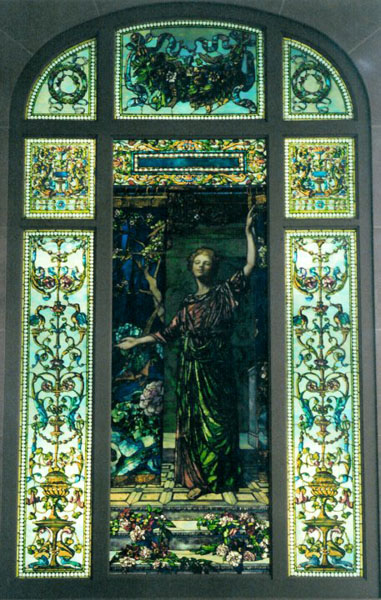
from flickrite miai c
Entire press release below the fold -
New American Wing Galleries Open May 19
Reconfigured Charles Engelhard Court, Balcony Galleries, and Historic Rooms Represent Second Part of Multi-Year Construction Project
Opening: May 19, 2009
Press Preview: NEW DATE: Thursday, May 14, 10:00 a.m.–1:00 p.m.
When The Charles Engelhard Court—the grand, light-filled pavilion that has long served as the formal entrance to The Metropolitan Museum of Art's American Wing—reopens this spring after two years of construction and renovation, the Museum's unparalleled collections of American ceramics, sculpture, stained glass, architectural elements, silver, pewter, glass, and jewelry will finally be seen in all their glory. So, too, will its early American rooms—12 of the Met's historic interiors, mostly from the colonial period, located on three floors of the wing's historic core—that have been reordered, renovated, and reinterpreted. The popular American Wing Café will also reopen in its previous location on the park side of the court. The opening of the galleries marks the completion of the second part (begun in May 2007) of a project to reconfigure, renovate, or upgrade nearly every section of The American Wing by 2011.
Morrison H. Heckscher, the Lawrence A. Fleischman Chairman of The American Wing, described the project as "architecture in the cause of art." He continued: "The goal of the comprehensive renovation of The American Wing is to present the Museum's superlative collections in the clearest and most logical, as well as most beautiful, manner possible. Toward that end, we have called upon the building itself—in the use of clear glass for walls and parapets and even a new public elevator, for example—to provide visual access to all facets of the collections."
The Charles Engelhard Court
Upon entering The Charles Engelhard Court, visitors will immediately encounter a new display of some 60 examples of large-scale sculpture, mosaics, stained glass, and architectural elements. The monumental sculpture collection will be installed on a new main-floor level—near the stunning loggia designed by Louis Comfort Tiffany for the main entrance of Laurelton Hall (about 1905), his Oyster Bay, Long Island, residence—as well as on a lower level in front of the façade of Martin E. Thompson's Branch Bank of the United States (1822–24), originally located at 15 1/2 Wall Street in New York City. Included will be marble and bronze figurative works by such American master sculptors as Hiram Powers (1805–1873), Augustus Saint-Gaudens (1848–1907), Harriet Whitney Frishmuth (1880–1980), and Paul Manship (1885–1966). These familiar works have been reinstalled in new groupings to encourage aesthetic and thematic comparisons and allow viewers unprecedented up-close access. Notable is the relocation of the marble Milmore and Melvin memorials by Daniel Chester French (1850–1931) from the balcony to the first floor, where they can be appreciated in proximity to other superlative American Beaux-Arts sculptures. The popular pool feature has been redesigned to showcase two bronze fountains by Frederick William MacMonnies (1863–1937) and Janet Scudder (1869–1940) that are piped to spout water. John La Farge's ambitious allegorical Welcome Window (1908–9)—a virtuosic work in stained glass—will be installed next to Saint-Gaudens's marble-and-mosaic tour de force Vanderbilt Mantelpiece (1881–83). American neoclassical marbles of the mid-19th century will return to the courtyard, displayed in a distinct group between a new seating area and the Branch Bank façade.
Balcony Galleries
The American Wing's outstanding collections of ceramics, glass, silver, and pewter will be installed in the balcony galleries in an integrated chronological sequence, beginning with the colonial period on the east side and continuing into the 20th century on the west, overlooking Central Park. Individual cases will be arranged by medium or theme. Among the highlights of the silver display will be the work of such familiar names as Paul Revere, Jr., and Tiffany & Company. A newly constructed mezzanine-level balcony, accessible via a staircase in the northwest corner, will be devoted almost entirely to the display of a major recent acquisition—250 superb examples of American art pottery crafted between 1876 and 1956, a promised gift of Robert A. Ellison Jr.—that has never before been publicly seen. Stained-glass windows of the same period, by Frank Lloyd Wright (1867–1959), William Gray Purcell (1880–1965) and George Grant Elmslie (1869–1952), and George Washington Maher (1864–1926) that incorporate large amounts of clear glass will also be installed nearby, with Central Park visible through them.
Additional stunning examples of mid-19th-century ecclesiastical stained-glass windows, installed on the upper balcony to allow for close examination by visitors, will be visible from the courtyard, approximating their original vantage points. Work by every major designer of American stained glass will be represented in this display, the most comprehensive presentation in any American museum.
In all, nearly 1,000 works of art will be exhibited, including two new cases devoted entirely to American jewelry, ranging from early 18th-century mourning rings to surprising works of the Arts & Crafts period. From the courtyard below, the new glass-fronted balconies will reveal a panoply of color, form, and brilliance.
Period Rooms
The American Wing's 20 period rooms—19 of which return to view this spring— provide an unparalleled view of American domestic architecture and interior design over three centuries. Twelve rooms, dating from 1680 to 1810, have been newly renovated. The new installation also involved the removal of several interiors of minor interest, the relocation of two 18th-century rooms (the Verplanck Room, 1767, and the Marmion Room, 1756), and the addition of one new room—from the 1751 Daniel Peter Winne house near Albany, New York—which will be among the rooms opening this May. Built in the Dutch architectural tradition, the Winne Room will be used as a gallery for the display of the Museum's superb collection of furniture, silver, painted glass, and early portraiture made and used in the Dutch cultural areas of colonial New York.
With the renovation of the period rooms, visitors will be able to take a complete tour of American interiors and decorative arts in chronological sequence, from the 17th century (the Hart Room, 1680) to the 20th century (the Frank Lloyd Wright Room, 1912–14). A new glass elevator will carry visitors directly to the third floor, where the earliest rooms are located.
Recent research has led to changes in the appearance or interpretation of several of the rooms.
Touch-screen computers will allow the public to access many layers of information about each room, with sections on the objects that are displayed in it, the architecture of the house that the room came from, the original owners, and the history of the room and its installation after it came to the Metropolitan Museum.
The rooms on each floor surround three main decorative arts galleries, which will be newly installed with fine examples of American furniture and portraiture. These will include masterpieces by 18th-century cabinetmakers such as John Townsend of Newport and Thomas Affleck of Philadelphia, and 19th-century counterparts Duncan Phyfe and Charles Honoré Lannuier of New York.
The Erving and Joyce Wolf Gallery
Located within The American Wing, The Erving and Joyce Wolf Gallery is one of some 20 spaces at the Museum specifically designed to accommodate several special exhibitions per year. As part of this second phase of renovations, new wood floors and new lighting were installed in the space. The first exhibition to be housed in the renovated gallery is Augustus Saint-Gaudens, opening June 30, 2009.
The final phase of the American Wing renovation project will include the American paintings and sculpture galleries and the addition of eight completely new galleries for the display of the Museum's superb collection of this material.
Related Programs
A variety of education programs will be offered in conjunction with the New American Wing galleries opening this May, including: a May 30 afternoon of lectures in the Sunday at the Met program; gallery talks focusing on the variety of media and styles of art on view; family programs for children ages 5-12 and accompanying adult; and workshops for adults with visual impairments, as well as for families with children and adults with learning and/or developmental disabilities.
Special online features about The American Wing are available on the Museum's website (www.metmuseum.org).
Audio Guides for The American Wing will be available. Forty-two new audio messages, featuring conversations with American wing curators, will be produced about the works in the new galleries. The fee for rentals is $6 for members of the Museum, $7 for non-members, and $5 for children under 12.
The Audio Guide program is sponsored by Bloomberg.
The popular American Wing Café will reopen May 19 in The Charles Engelhard Court, serving traditional American favorites. Its hours are 11:00 a.m. to 4:30 p.m. Sunday, Tuesday, Wednesday, Thursday; and 11:00 a.m. to 8:30 p.m. Friday and Saturday.
Credits
The project is under the general direction of Morrison H. Heckscher, the Lawrence A. Fleischman Chairman of The American Wing, and Peter M. Kenny, Curator of American Decorative Arts and Administrator of The American Wing. The installations within The Charles Engelhard Court were coordinated by Alice Cooney Frelinghuysen, the Anthony W. and Lulu C. Wang Curator of American Decorative Arts, together with Beth Carver Wees, Curator of American Decorative Arts, and Thayer Tolles, Associate Curator of American Painting and Sculpture. The period room installations were overseen by Amelia Peck, the Marica Vilcek Curator of American Decorative Arts. The overall project architect is Kevin Roche John Dinkeloo and Associates LLP; the Engelhard Court installations are by Michael Lapthorn, Exhibition Designer; the period room installations are by Stephen Saitas Design; and lighting is by Richard Renfro Associates.
Conservation of works of art in all media was carried out under the general direction of Lawrence Becker, Sherman Fairchild Conservator in Charge, with Linda Borsch and Marijn Manuels, Conservators, and Drew Anderson, Associate Conservator, all of the Department of Objects Conservation.
The Metropolitan Museum gratefully acknowledges the following lead contributors to the project: Margaret and Raymond J. Horowitz, Anthony W. and Lulu C. Wang, Mr. and Mrs. Richard L. Chilton, Jr., The Peter Jay Sharp Foundation, Juliana and Peter Terian, Jan and Warren Adelson, Max and Heidi Berry, Ambassador and Mrs. W. L. Lyons Brown, Joyce Berger Cowin, Jane and Maurice Cunniffe, Barbara G. Fleischman and Martha J. Fleischman, Peggy N. and Roger G. Gerry Charitable Trust, The Henry Luce Foundation, Elizabeth and Richard Miller, Oceanic Heritage Foundation, Doris and Stanley Tananbaum, and Barrie and Deedee Wigmore.
# # #
April 28, 2009
May 11, 2009
LIFE Photo Archive Online
If you haven't done it already, check out the LIFE Photo Archive hosted by Google.
When I was growing up in the mid-60's, LIFE magazine was for me the most important part of the weekly news cycle. This was because LIFE magazine had the best images of current events. Movies created big beautiful images, but it was never 'current' enough. TV was immediate, but at that time the image quality was lousy, mostly filled with still studio sets and talking heads. LIFE magazine was the grand canvas for current world news and culture. It’s almost impossible for anyone under the age of 40 to even imagine what kind of anticipation there was waiting for the current issue of LIFE magazine to show up in your mailbox once a week. Of course, all that changed rapidly as TV mobile technology improved, and then cable TV expanded the number of images, and eventually the internet came in with even more diverse and instant imagery.
So, as this is a blog about stained glass, I was curious to see what would show up in a search for 'stained glass' in the LIFE image archives. Some images I expected, like 20th century modern art related stained glass (LIFE's heyday was from about 1940-1970). In some cases, where I might expect to find something, there was nothing. For example, there are images of the National Cathedral, but no stained glass.
And there were some very odd surprises. More on that later.
One example of a totally expected image. French painter Marc Chagall working on a stained glass window, circa 1960. Expected since I remember a good number of photo essays on modern artists in the pages of LIFE.
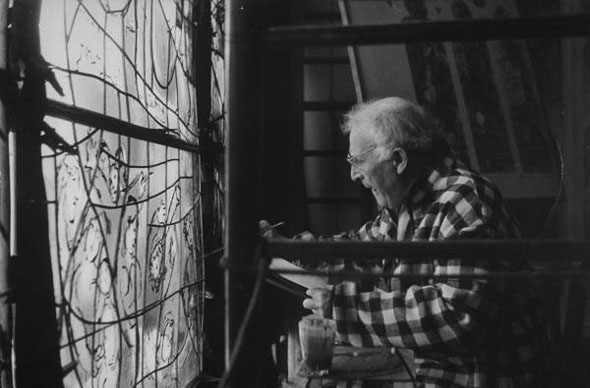
more modern artists and a few oddities after the fold...
all images © Time, Inc.
Modern stained glass artists in LIFE
Henry Matisse in 1951 at perhaps the most famous of '20th century modern' stained glass commissions - Vence Chapel.
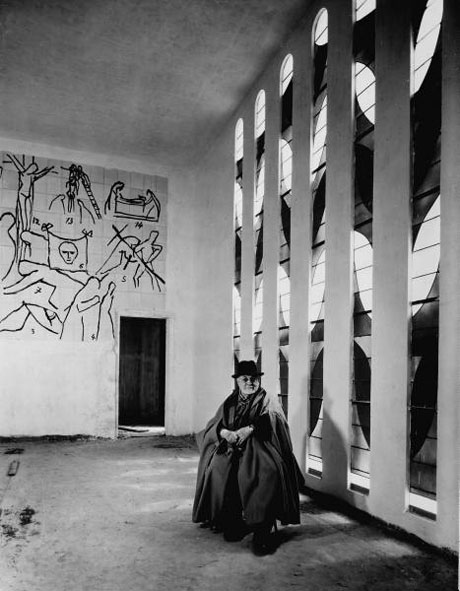
The stained glass artist who translated Matisse's designs was Paul Bony, from 1949.
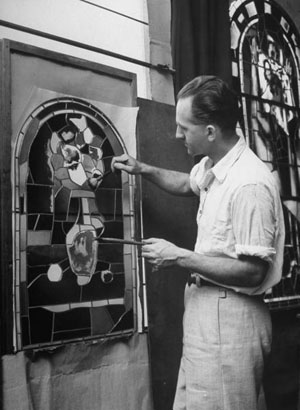
The Robert Sowers Kennedy airport windows, from 1961. I expected this in LIFE, but not with such nice hi-res color shots. This is the commission that was recently dismantled.

Interior
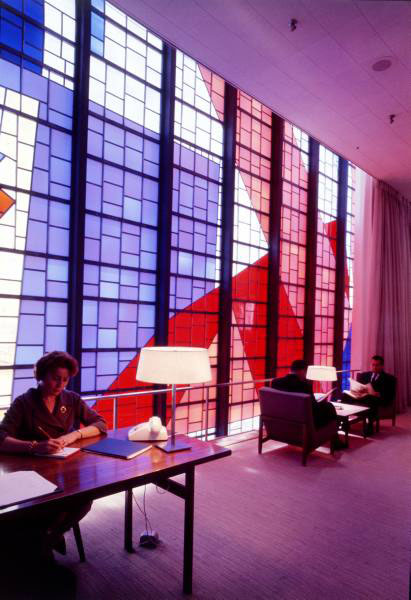
Young Seigfried Reinhardt, in 1952, before he became the stained glass artist Siegfried Reinhardt. There are some 72 shots in this photo archive.
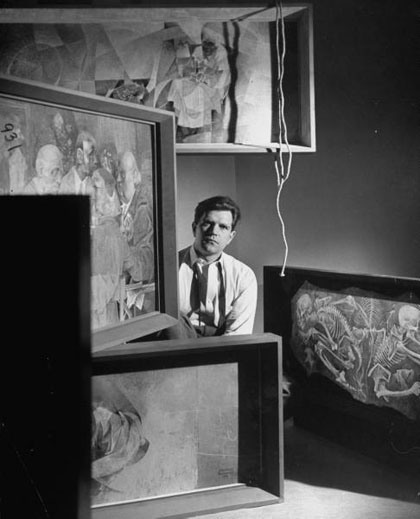
Stained Glass in LIFE - the oddities
A creepy oddity -
Dedication of a stained glass window to J. Edgar Hoover, circa 1966.
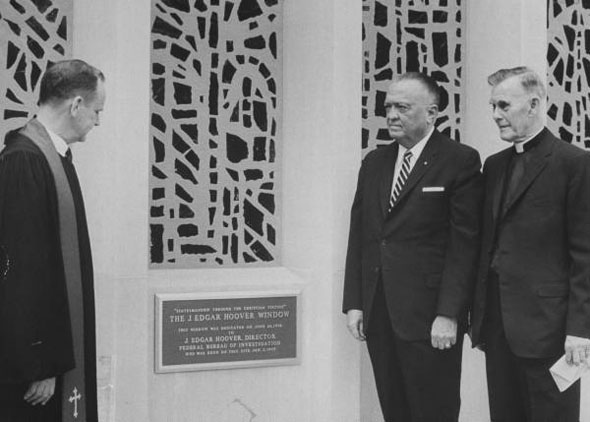
From a quick net search this seems to be taking place at Capitol Hill Methodist Church, though there is no mention of the Hoover connection on their website. No big surprise in that.
A nice oddity -
The Stained Glass House, circa 1971. This is someone's house in the woods. No further info given, other than that the Photographer was John Dominis.
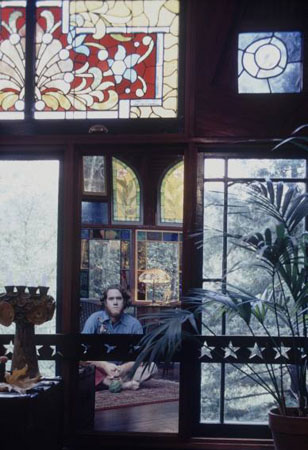
And, finally, a beyond bizarre oddity -
Anti-Religious Museum, Moscow 1941, photos by Margaret Bouke-White
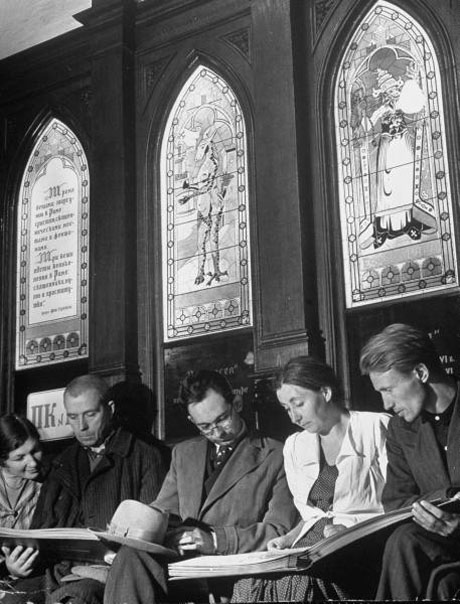
the windows in more detail.
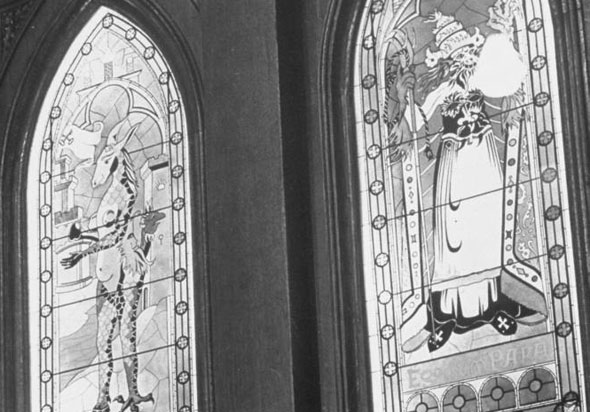
Obviously not real windows, but one still cannot help but react with utter bafflement.
There are more images throughout the LIFE archive related to stained glass. There was an issue with Chartres as the cover, but the quality of the images (at least the ones online) are surpisingly poor.
May 10, 2009
Mary Clerkin Higgins Lecture
A talk on Stained Glass and Conservation by Mary Clerkin Higgins.
Bio as a member of board of directors of the American Glass Guild
Website, only a home page, under construction.
It's a longish presentation (roughly 1 hour, 15 minutes) and you can't see the slides very well, but it's worth it, especially if you are fairly new to working in stained glass. Roughly speaking, the 1st third is about materials and process, the 2nd third is a history of stained glass, and the last third is about conservation techniques, with examples. The information is rock solid. Mary is one of the best in the biz.
Here is the link on Truveo if it doesn't work for you here. Curiously, there is no information on date or origin of the video.
May 05, 2009
'Twibing' Stained Glass
I’ve been a little over a month on twitter now -
http://www.twitter.com/vitreosity
I’m still skeptical but still interested in the possibilities.
I find the 140 character limit surprisingly intriguing, as it forces you to focus and make your thoughts clear and straightforward.
Still, the whole ‘follower’ and ‘following’ thing is confusing and a bit maddening to me, and man-o-man do I get tired of the whole ‘what I’m doing right now’ small talk and chitchat. Twitter is indeed awash with that.
So, I’m trying something different. There is a thing called ‘twibes’, and if you have a twitter account, you can join. I created a ‘twibe’ specifically for people interested in stained glass.
http://www.twibes.com/stained_glass
It aggregates twitter messages by narrowing the search to three words you choose. That is, if you have a twitter account and sign up with the ‘stained_glass twibe’, anytime you do a tweet that includes the words ‘stained’ OR ‘glass’ OR ‘art’, your tweet will be posted on the ‘stained_glass twibe’ automatically. Theoretically, you can go to the 'stained_glass twibe' site and get the links, insights and thoughts of those who are especially interested in stained glass.
I have no idea whether or not this will attract stained glass professionals or enthusiasts, or if it will further the discourse between different people interested in stained glass. It’s very new, and a guess and a gamble. But there is nothing to lose, except a little more time in following the experiment. Frankly, I’d be surprised if it worked out the way I would like or imagine.
Still, I can always mark it down to research and development.
Or in twitterspeak - Call it R&D
